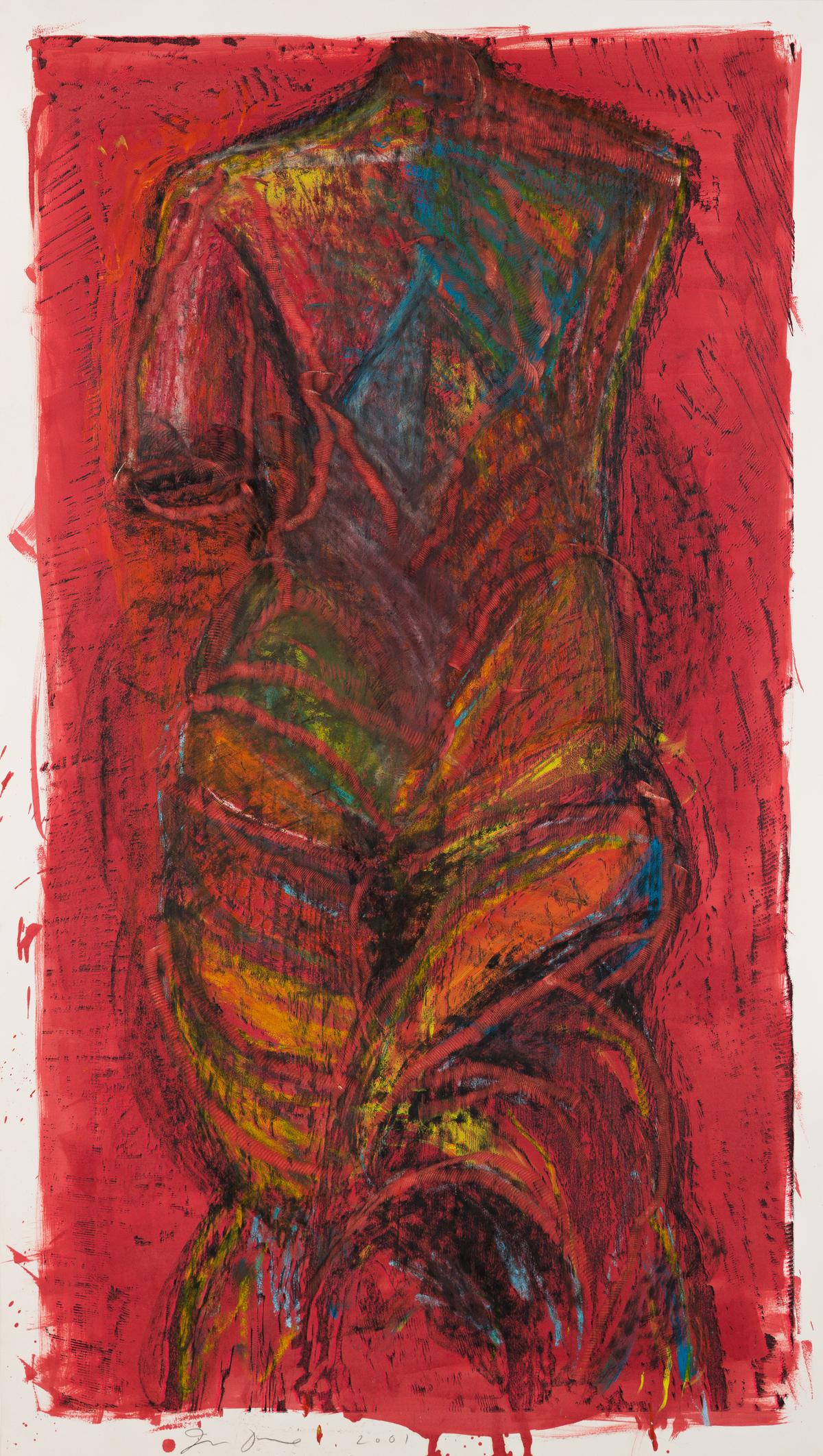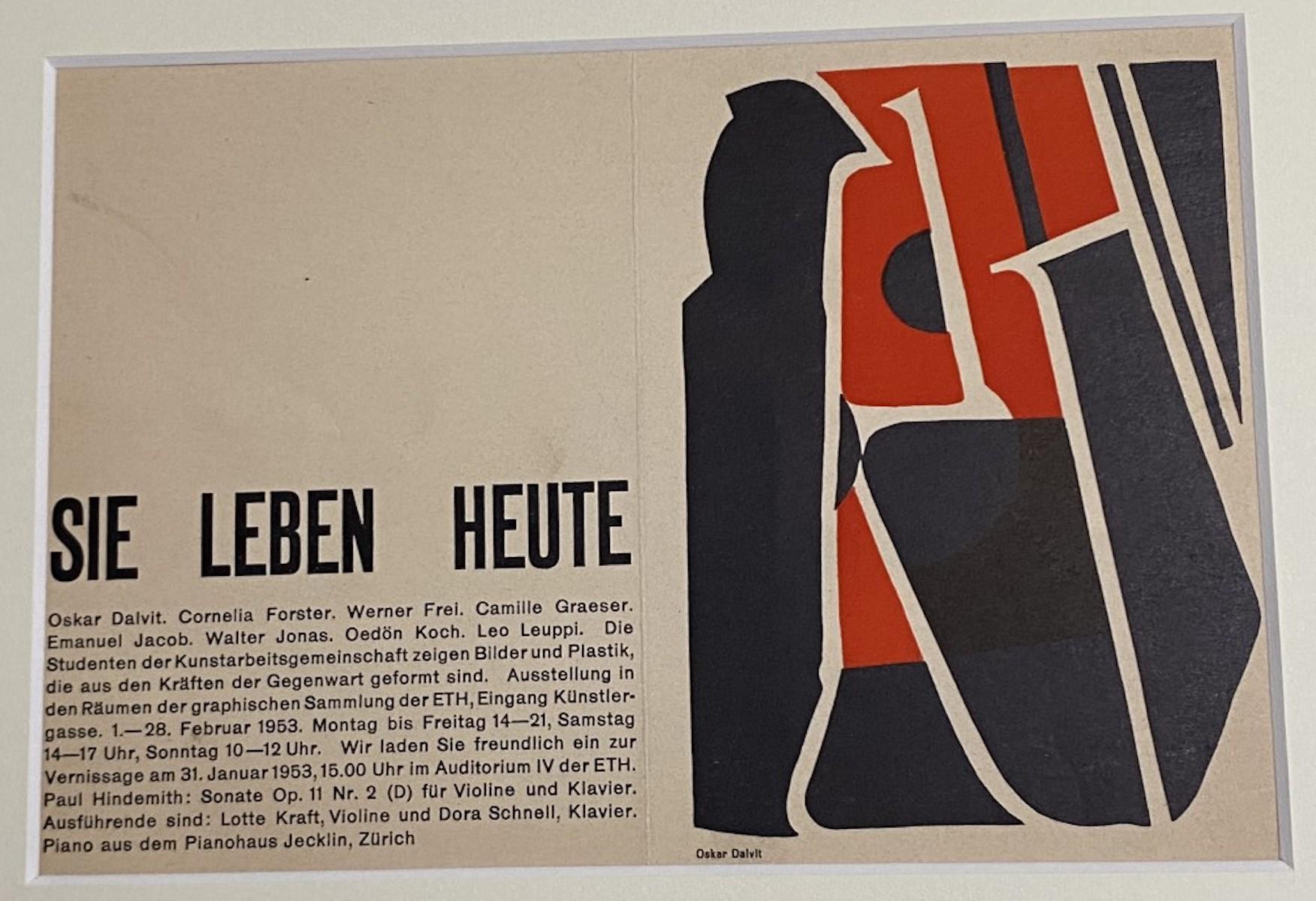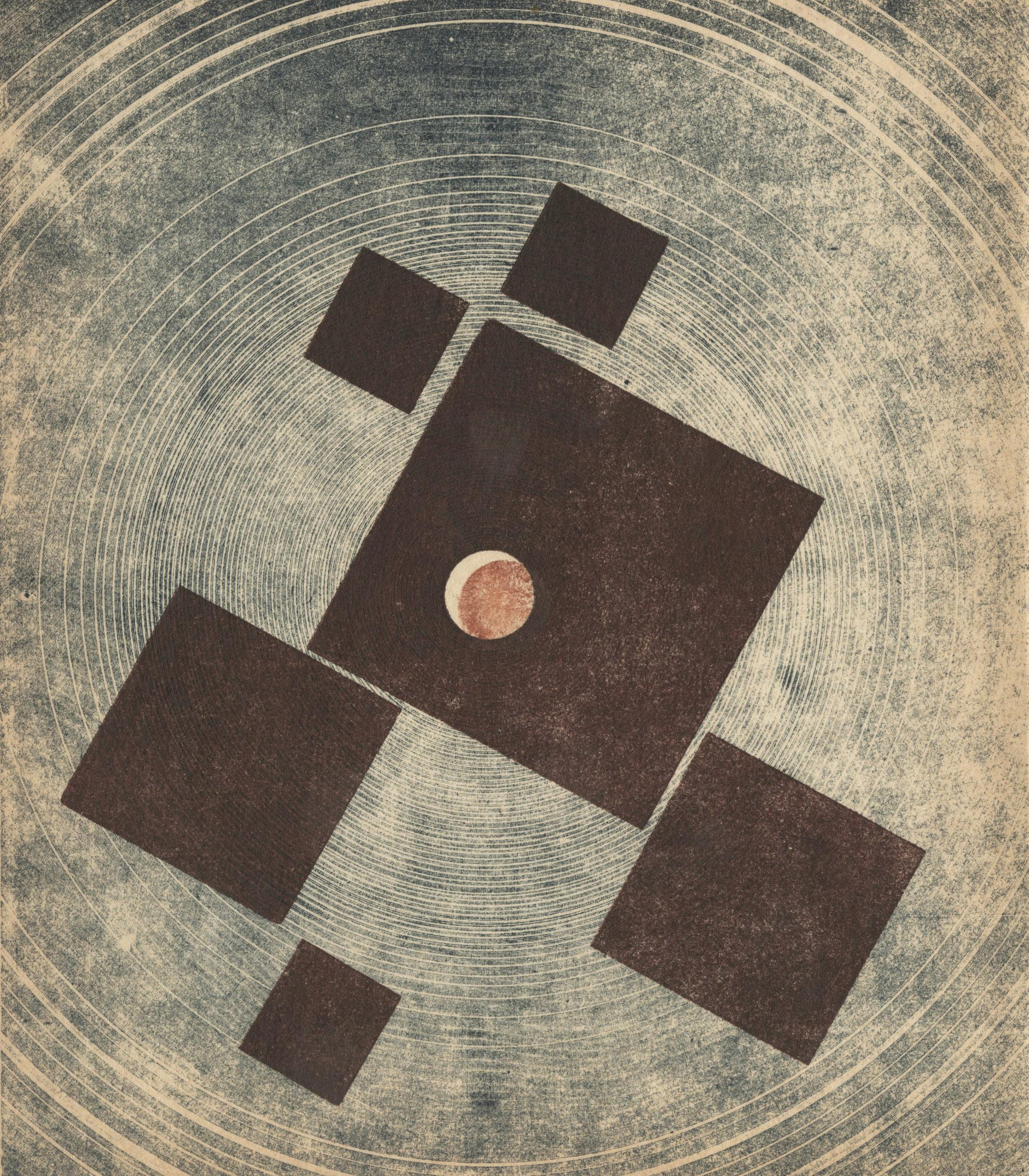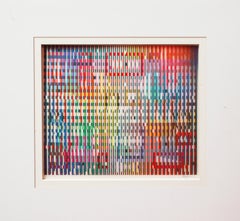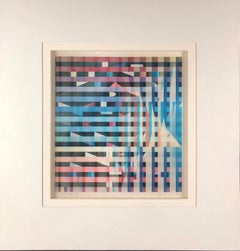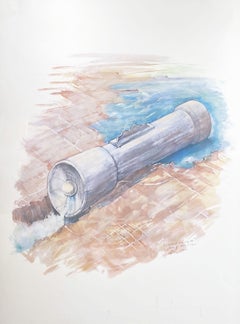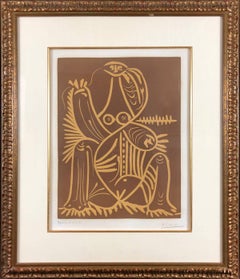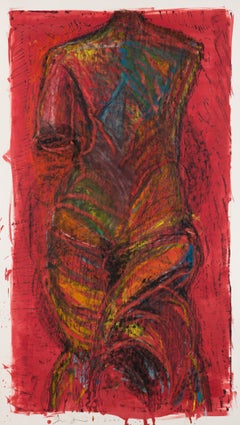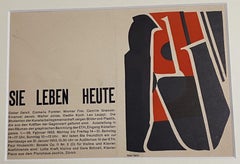Want more images or videos?
Request additional images or videos from the seller
1 of 6
Hans (Jean) ArpSoleil Recercle1966
1966
About the Item
Soleil Recercle
Color woodcut, 1966, on wove,
Signed and Numbered ed. 50
Cat. Rais. Arntz
Sheet Size: approx. 22 x 17.5 inches
Framed Size: approx. 24 x 20 inches
Jean Arp was a painter, a poet and sculptor. He was born on September 16, 1886 in Strasbourg, which is in the area known as Alsace-Lorraine, near the boundary of Germany and France. His art retained a feeling for life on the border. He balanced a Gallic playfulness with a romantic mysticism that is essentially German. (He wrote in both languages). He longed to escape from the conventional borders of modern life, into a community of the spirit. He considered realistic art absurdly limited and egotistical. In 1904 he studied at the School of Decorative Arts, Strasbourg; he took further training in Weimar. In 1908 he traveled to Paris to enroll in the Academie Julian. Arp produced paintings that were almost abstract in design. In 1912 he visited Kandinsky and briefly joined the Blaue Reiter; he showed at the first Autumn Exhibition.
He returned to Paris in 1914 and became friendly with Picasso, Modigliani and Robert Delaunay. He founded the Dada Movement in Switzerland after World War I, then brought the Dadaist ideas to Cologne. He married Sophie Taeuber in 1921. She was an important Swiss artist. More than just an influence, she was an inspiration to Arp. Her "clear work and clear life," he once wrote, "showed me the right way, the way to beauty."
Arp took part in the Surrealist circle for a short period. He settled in Meudon, outside Paris. His few paintings all date before 1914. In his Dada and Surrealist periods he concentrated on collages, in drawings and reliefs, in painting on perforated wood or designs with wool. He was drawn more to sculpture during his mature years; also engraving, tapestry and poetry.
Jean Arp is one of the gentle revolutionaries of modern art. Important to the dada and surrealist movements and a significant poet as well as artist, he helped shape the modernist faith. He attacked the barbarism of the 20th century, mocked the vanity of reason and sought an art of spirital regeneration. A pioneer of abstract art, he developed one of its principal visual vocabularies: biomorphe shapes that invoke nature. Yet Arp remained free of the angry swagger, the desire to pack the big punch, that characterized many of his contemporaries. His art is light as air, and his contempt is softened by humor. He was a twinkling sort of man. Today nothing is rarer than the light touch.
As a dadaist in Zurich in 1916-1918, he joined Taeuber is making geometric abstract art. They aspired to the impersonality of divine order and avoided making marks that looked too individual. Arp never made a tight picture. He allowed a happy relaxation, a formal gaiety into the composition.
Rigorous geometry was more to Taeuber's taste than his, and Arp soon found another way to render his utopian fancies. He created an imagery that evoked rocks, leaves, twigs, birds. He did not actually depict such things but suggested the play of nature as it germinates, ripens, decays. He became increasingly interested in an oval shape, which he would refer to as a navel, a symbol of life itself.
Arp treasured chance - collisions of coincidence, slips of tongue and pen and brush, meetings between strangers. At such moments the world woke up and the ordinary became remarkable. As he grew older, Arp make simple "constellations" of forms, which suggest the play of both cells and heavenly bodies. Upon discovering that some of his early works were damaged in storage, he tore them up and remade them into collages - a symbol of decay and regeneration. The sensous curves of his sculpture, reminiscent of breast and buttocks, invite the caress of a palm.
Nightmares rarely intrude on Arp's dreamy work. Still, the later art is heavier in spirit. The accidental death of Taeuber in 1943 depressed him profoundly. He made a kind of fetish of her memory. His art, especially the sculpture, became more conventional, less magical. In the earlier work, what's really impressive is exactly what exasperated some people about Arp's creations: the childish throwaway quality. The art is almost not art. It lacks finish - finishing would be a kind of death. It's so loose. No early work looks like it costs money. It's as light, as quick, as free as inspiration itself. A squiggle is a bow tie, a mustache, a smile, a bird.
During World War II, he lived in retirement at Grasse. At the conclusion of the war he returned to Meudon, near Paris. He involved himself doing sculpture, writing poetry, etc. In 1949-50 be visited the United States and completed a monumental wood and metal relief for Harvard University, and a mural relief for the UNESCO Building in Paris in 1958. He won the international prize for sculpture at the Venice Biennale in 1954, He died in 1966.
Arp has been called "one of the strangest personalities of this century". There were few groups to which he was not made welcome and few movements to which he was not attached. Yet a certain naive and childlike quality remained distinctive in his art. He founded no school and had no disciples, yet cumulatively his influence on the development of contemporary art has been great.
Written and compiled by Jean Ershler Schatz, artist and researcher of Laguna Woods, California.
Sources:
The Oxford Companion to 20th Century Art, edited by Harold Osborn
Mark Stevens in Newsweek, August 24, 1987
- Creator:Hans (Jean) Arp (1886-1966, French)
- Creation Year:1966
- Dimensions:Height: 24 in (60.96 cm)Width: 20 in (50.8 cm)
- Medium:
- Movement & Style:
- Period:
- Condition:
- Gallery Location:Missouri, MO
- Reference Number:1stDibs: LU74732276001
About the Seller
5.0
Vetted Professional Seller
Every seller passes strict standards for authenticity and reliability
Established in 1970
1stDibs seller since 2017
153 sales on 1stDibs
Typical response time: 17 hours
- ShippingRetrieving quote...Shipping from: Missouri, MO
- Return Policy
Authenticity Guarantee
In the unlikely event there’s an issue with an item’s authenticity, contact us within 1 year for a full refund. DetailsMoney-Back Guarantee
If your item is not as described, is damaged in transit, or does not arrive, contact us within 7 days for a full refund. Details24-Hour Cancellation
You have a 24-hour grace period in which to reconsider your purchase, with no questions asked.Vetted Professional Sellers
Our world-class sellers must adhere to strict standards for service and quality, maintaining the integrity of our listings.Price-Match Guarantee
If you find that a seller listed the same item for a lower price elsewhere, we’ll match it.Trusted Global Delivery
Our best-in-class carrier network provides specialized shipping options worldwide, including custom delivery.More From This Seller
View AllAbstract Composition
By Yaacov Agam
Located in Missouri, MO
Yaacov Agam
"Abstract Composition"
Agamograph
Ed. 17/25
Signed and Numbered
Site Size: approx 13 x 16 inches
Framed: approx. 22.5 x 24.5 inches
An agamograph is a series of images ...
Category
Late 20th Century Modern Abstract Prints
Materials
Screen
Price Upon Request
Abstract Composition - Pyramid
By Yaacov Agam
Located in Missouri, MO
Yaacov Agam
"Abstract Composition"
Agamograph
Ed. 87/99
Signed and Numbered
Site Size: approx 16 x 13 inches
Framed: approx. 24.5 x 22.5 inches
An agamograph is a series of images ...
Category
Late 20th Century Modern Abstract Prints
Materials
Screen
Price Upon Request
Colossal Flashlight in Place of Hoover Dam
By Claes Oldenburg
Located in Missouri, MO
Colossal Flashlight in Place of Hoover Dam, 1982
By Claes Oldenburg (Swedish, American, 1929-2022)
Signed Lower Right
Dated Middle Right
Unframed: 23" x 22"
Framed: 36.5" x 27.5"
Whimsical sculpture of pop culture objects, many of them large and out-of-doors, is the signature work of Swedish-born Claes Oldenburg who became one of America's leading Pop Artists. He was born in Stockholm, Sweden. His father was a diplomat, and during Claes' childhood moved his family from Stockholm to a variety of locations including Chicago where the father was general consul of Sweden and where Oldenburg spent most of his childhood. He attended the Latin School of Chicago, and then Yale University where he studied literature and art history, graduating in 1950, the same year Claes became an American citizen.
Returning to Chicago, he enrolled at the Art Institute of Chicago from 1952 to 1954 and also worked as a reporter at the City News Bureau. He opened his own studio, and in 1953, some of his satirical drawings were included in his first group show at the Club St. Elmo, Chicago. He also painted at the Oxbow School of Painting in Michigan.
In 1956, he moved to New York where he drew and painted while working as a clerk in the art libraries of Cooper-Union Museum for the Arts of Decoration. Selling his first artworks during this time, he earned 25 dollars for five pieces.
Oldenburg became friends with numerous artists including Jim Dine, Red Grooms and Allan Kaprow, who with his "Happenings" was especially influential on Oldenburg's interest in environmental art. Another growing interest was soft sculpture, and in 1957, he created a piece later titled Sausage, a free-hanging woman's stocking stuffed with newspaper.
In 1959, he had his first one-man show, held at the Judson Gallery at Washington Square. He exhibited wood and newspaper sculpture and painted papier-mache objects. Some viewers of the exhibit commented how refreshing Oldenburg's pieces were in contrast to the Abstract Expressionism, a style which much dominated the art world. During this time, he was influenced by the whimsical work of French artist, Bernard Buffet, and he experimented with materials and images of the junk-filled streets of New York.
In 1960, Oldenburg created his first Pop-Art Environments and Happenings in a mock store full of plaster objects. He also did Performances with a cast of colleagues including artists Lucas Samaras, Tom Wesselman, Carolee Schneemann, Oyvind Fahlstrom and Richard Artschwager, dealer Annina Nosei, critic Barbara Rose, and screenwriter Rudy Wurlitzer.
His first wife (1960-1970) Pat Muschinski, who sewed many of his early soft sculptures, was a constant performer in his Happenings. This brash, often humorous, approach to art was at great odds with the prevailing sensibility that, by its nature, art dealt with "profound" expressions or ideas.
In December 1961, he rented a store on Manhattan's Lower East Side to house "The Store," a month-long installation he had first presented at the Martha Jackson Gallery in New York. This installation was stocked with sculptures roughly in the form of consumer goods.
Oldenburg moved to Los Angeles in 1963 "because it was the most opposite thing to New York I could think of". That same year, he conceived AUT OBO DYS, performed in the parking lot of the American Institute of Aeronautics and Astronautics in December 1963.
In 1965 he turned his attention to drawings and projects for imaginary outdoor monuments. Initially these monuments took the form of small collages such as a crayon image of a fat, fuzzy teddy bear looming over the grassy fields of New York's Central Park (1965) and Lipsticks in Piccadilly Circus, London (1966). Oldenburg realized his first outdoor public monument in 1967; Placid Civic Monument took the form of a Conceptual performance/action behind the Metropolitan Museum of Art, New York, with a crew of gravediggers digging a 6-by-3-foot rectangular hole in the ground.
Many of Oldenburg's large-scale sculptures of mundane objects elicited public ridicule before being embraced as whimsical, insightful, and fun additions to public outdoor art. From the early 1970s Oldenburg concentrated almost exclusively on public commissions.
Between 1969 and 1977 Oldenburg had been in a relationship with Hannah Wilke, feminist artist, but in 1977 he married Coosje van Bruggen, a Dutch-American writer and art historian who became collaborator with him on his artwork. He had met her in 1970, when she curated an exhibition for him at the Stedelijk Museum in Amsterdam. Their first collaboration came when Oldenburg was commissioned to rework Trowel I, a 1971 sculpture of an oversize garden tool, for the grounds of the Kröller-Müller Museum in Otterlo, the Netherlands.
Oldenburg has officially signed all the work he has done since 1981 with both his own name and van Bruggen's. In 1988, the two created the iconic Spoonbridge and Cherry sculpture for the Walker Art Center in Minneapolis, Minnesota that remains a staple of the Minneapolis Sculpture Garden as well as a classic image of the city. Typewriter Eraser...
Category
20th Century American Modern Abstract Prints
Materials
Paper, Lithograph
Price Upon Request
Diurnes (Femme Assise En Pyjama De Plage II)
By Pablo Picasso
Located in Missouri, MO
Pablo Picasso
"Diurnes" (Femme Assise En Pyjama De Plage II) 1962
Linocut printed in ochre and brown, 1962, on Arches paper
Inscribed "Epreuve D'Artist" (Artist Proof) lower left, as...
Category
1960s Modern Abstract Prints
Materials
Linocut
Price Upon Request
Trova/Index, Waves
By Ernest Tino Trova
Located in Missouri, MO
Trova/Index, Waves, 1969
By. Ernest Tino Trova (American, 1927-2009)
Signed in Pencil Lower Right
Unframed: 10.5 x 7.5 inches
With Frame: 15.25 x 11.75 inches
Known for his Falling ...
Category
20th Century American Modern Abstract Prints
Materials
Screen
Price Upon Request
Study/Falling Man (Series I)
By Ernest Tino Trova
Located in Missouri, MO
Study/Falling Man (Series I), 1967
By. Ernest Tino Trova (American, 1927-2009)
Signed Lower Right in Pencil
Screenprint, Available in Black or Silver Frame
Unframed: 6 x 6 inches
Wit...
Category
20th Century American Modern Abstract Prints
Materials
Screen
Price Upon Request
You May Also Like
Singing and Printing XIII
By Jim Dine
Located in New York, NY
JIM DINE
Singing and Printing XIII.
Unique color woodblock relief print with hand coloring in oil, acrylic, and charcoal and mechanical abrasion on cream wove paper, 2001.
69 3/4 x ...
Category
Early 2000s Modern Abstract Prints
Materials
Charcoal, Oil, Acrylic, Color, Woodcut
Invitation to Exhibition - Original Woodcut by Oscar Dalvit - 1953
Located in Roma, IT
Invitation to an exhibition is an original woodcut on paper realized by Oscar Dalvit (1911-1975).
Passepartout including: cm 30 x 40.
Image Dimensions: 14.5 x 20.5 cm
Very good c...
Category
1950s Modern Abstract Prints
Materials
Woodcut
Max Weber, Figure
By Max Weber
Located in New York, NY
One of America's great modernist innovators, Max Weber carved Figure, 1919-20, on the end piece of a wooden cigar box. This Cubist image is composed o...
Category
Early 20th Century Modern Figurative Prints
Materials
Woodcut
(Abstraction) by DD
Located in New York, NY
This image is an extravaganza of modernist motifs. The monogram 'D.D.' is at the lower right.
Category
Mid-20th Century American Modern Abstract Prints
Materials
Woodcut
Untitled
By Charles William Smith
Located in Fairlawn, OH
Untitled
Color woodcut, 1939
Unsigned as issued
Signed and dedicated by the artist on the justification page (see photo)
From:
Abstractions By Charles Smith
Forward by Carl O. Schnie...
Category
1930s American Modern Abstract Prints
Materials
Woodcut
Modern Abstract Woodcut by John Tandy
By John Tandy
Located in Long Island City, NY
John Tandy, painter and stage designer, studied at the Architectural Association before becoming a student at Leon Underwood's Brook Green school and later studying at the Grosvenor ...
Category
1930s Modern Abstract Prints
Materials
Woodcut
Recently Viewed
View AllMore Ways To Browse
Oval Prints
Tapestry French Romantic
Vintage Metal Punches
Big Cat Sculptures
1960 Vanity Light
Angry Cat
Osborn Woods
Ralph Hurst
Ralph Prata
Ramie 159
Ramie 610
Randy Stromsoe
Red Tail Black Cockatoo Painting
Rider And The Green Dragon
Rob Zweerman
Robert Murdoch Wright
Robert Rauschenberg Horsefeathers
Robert Rauschenberg Skateboard
